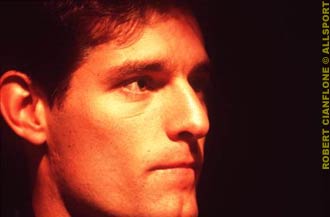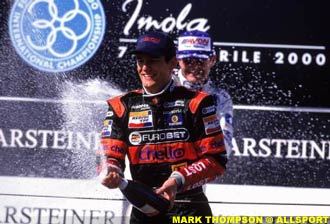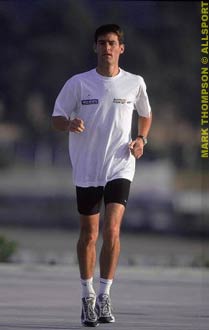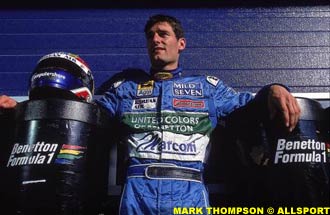 For Mark Webber, Formula One has come via a long and winding route. While Jenson Button has spent single seasons in both Formula Ford and Formula 3, and Sauber's wonderkid, Kimi Raikkonen, has just a single season in Formula Renault, it has been five long years since Webber left his home country to pursue the dream of Formula One stardom.
For Mark Webber, Formula One has come via a long and winding route. While Jenson Button has spent single seasons in both Formula Ford and Formula 3, and Sauber's wonderkid, Kimi Raikkonen, has just a single season in Formula Renault, it has been five long years since Webber left his home country to pursue the dream of Formula One stardom.
But Webber, 24, is remarkably focused on the goal. He has turned down lucrative rides in CART and Touring Cars to stay in Europe - to stay as close as he can to the Formula One pulse. He knows where his priorities are: After a couple of false starts, including a testing role at TWR Arrows that never really came to fruition, in September this year Mark Webber completed a full Formula One test with Benetton, in the build up to the United States Grand Prix.
At that stage, Benetton was a team which at the time was embroiled with driver related problems. The generally disappointing Alexander Wurz was leaving the team, on his way to McLaren; Giancarlo Fisichella was under the lash of the sharp tongue of Flavio Briatore, newly returned master of Benetton's destiny; Jenson Button had just been signed to replace Wurz, in a very strange deal by Benetton's standards, as Button is on a two-year loan from Williams. And Benetton themselves have loaned drivers (Fisichella and Trulli) to other teams, but have not been on the receiving end of such a deal before, developing a young driver for someone else.
Webber joined the Benetton team at Estoril, which until 1996 was the home of the Portuguese Grand Prix. It is often still used by the teams as a test track, mainly due to generally good weather. Webber was under pressure not to damage the car, as it was scheduled for racing duties the following weekend at Indianapolis. Webber would have a benchmark, with Giancarlo Fisichella joining the test for a day. Williams would also be there with Bruno Junqueira, with Ralf Schumacher stopping by for a day.
 Chris Lambden, publisher of the Australian publication Motorsport News, travelled to Estoril for the test. "I don't think I've ever been more impressed with someone coping with the pressure of the biggest day of his life," commented Lambden. Webber's times dropped over the course of the test, beating the time set by Fisichella, as well as Junqueira in the Williams, and just two tenths slower than Ralf Schumacher. Benetton was immediately impressed with the quality of Webber's feedback. Impressed to the point that some team members expressed disappointment that the driver line-up for season 2001 was already set in concrete.
Chris Lambden, publisher of the Australian publication Motorsport News, travelled to Estoril for the test. "I don't think I've ever been more impressed with someone coping with the pressure of the biggest day of his life," commented Lambden. Webber's times dropped over the course of the test, beating the time set by Fisichella, as well as Junqueira in the Williams, and just two tenths slower than Ralf Schumacher. Benetton was immediately impressed with the quality of Webber's feedback. Impressed to the point that some team members expressed disappointment that the driver line-up for season 2001 was already set in concrete.
After a couple of near-podium places in a year-old Van Diemen in 1994, Mark Webber was one of a cluster of stars to emerge during the 1995 Australian Formula Ford Championship. Using a current model Van Diemen, Webber finished fourth in the series, having won three races. Only fourth? That's more a measure of the competition than anything else, with those ahead of him including Indy Lights star and CART racer Jason Bright, and Australian Nation's Cup Ferrari racer Mark Noske.
Webber journeyed to England for the Brands Hatch Formula Ford Festival, where he finished third in what is effectively the world championship of Formula Ford. After returning to Australia, he won a Formula Ford support race at the last Australian Grand Prix in Adelaide, and a few months later, again in front of the Formula One circus, won a Formula Holden (effectively Australian Formula 3000) race at the first Grand Prix held in Albert Park.
For the remainder of 1996, Webber joined the crack factory Van Diemen squad in the British Formula Ford Championship, long considered a gateway to higher success. Despite a slow start to the season, Webber claimed four wins to storm home to second place in the series behind teammate Kristian Kolby. He then went on to the European Cup race at Spa, which he won, in his first race at the daunting driver's circuit. Webber then returned to Britain, and won the Brands Hatch Formula Ford Festival.
 From there, Formula Three beckoned, and with the assistance of long time sponsor Australian 'Yellow Pages', Webber secured a seat with Alan Docking Racing in the 1997 British F3 championship. Webber was team leader at ADR, along with two 'pay' drivers, so he was without a competitive teammate. Despite this, he achieved a consistent string of podium places, including a win at Brands Hatch, taking him to fourth place in the championship, behind Johnny Kane, Peter Dumbreck and Nicolas Minassian.
From there, Formula Three beckoned, and with the assistance of long time sponsor Australian 'Yellow Pages', Webber secured a seat with Alan Docking Racing in the 1997 British F3 championship. Webber was team leader at ADR, along with two 'pay' drivers, so he was without a competitive teammate. Despite this, he achieved a consistent string of podium places, including a win at Brands Hatch, taking him to fourth place in the championship, behind Johnny Kane, Peter Dumbreck and Nicolas Minassian.
Along the way he had impressed Mercedes-Benz, culminating in a drive with their GT team in 1998. Mercedes had just revived their junior driver program, which had helped shape the careers of Michael Schumacher, Heinz-Harald Frentzen and Karl Wendlinger almost a decade earlier. Ricardo Zonta and Webber joined veterans Klaus Ludwig and Bernd Schneider in the World Sportscar series, including the famous 24 hour event at Le Mans, where Webber's car went out in the early laps after running strongly. The team's Mercedes CLK-GTR was clearly the dominant car in sports car racing, with Webber and Schneider collecting wins at Silverstone, Hockenheim, Hungaroring, Suzuka and Donington. The championship was fought out between the two factory AMG cars, going down to the final race at Laguna Seca, where an unfortunate spin by Webber handed the title to teammates Ludwig and Zonta.
For the following season, Webber and Schneider were set to continue as the team's two lead drivers, but in 1999, the political strife that never seems too far away from sports car regulations struck again, and the world championship was cancelled. Mercedes refocused its efforts, concentrating on Le Mans. The new CLR-LMs were tested extensively, with Webber performing the majority of the testing, completing thousands of laps. However, during practice for the race, Webber's car somersaulted spectacularly at over 300 km/h while following an Audi on the run towards Indianapolis. Suddenly the car lost all front downforce and flipped. Webber was not hurt, and the car was rebuilt.
Then in the morning warm-up, just hours before the race, driving down the Mulsanne straight the car flipped again with Webber at the wheel. Mercedes decided to continue, but added small winglets to the front of the two surviving cars in an effort to prevent their two remaining cars from getting airborne. But under five hours into the race, Peter Dumbreck duplicated Webber's first crash on the run to Indianapolis. The surviving car was immediately withdrawn. It was a debacle of the highest order and looked set to claim Webber's career along with it.
 However, towards the end of 1999, Webber's career was revived as he linked up with Paul Stoddart, owner of European Aviation and the European Aviation backed Formula 3000 team. Webber joined the team as lead driver for the team in the International Formula 3000 series. He also earned a couple of basic componetry tests with TWR Arrows. In the build up to the first Grand Prix of 2000, European Aviation was confirmed as Arrows junior team, and Webber as Arrows test driver. But it was well into the season before any meaningful test would come Webber's way. In the meantime, F3000 beckoned, and Webber took to it with gusto, with a fighting third place at the first round at Imola quickly followed by a brilliant wet weather win at Silverstone.
However, towards the end of 1999, Webber's career was revived as he linked up with Paul Stoddart, owner of European Aviation and the European Aviation backed Formula 3000 team. Webber joined the team as lead driver for the team in the International Formula 3000 series. He also earned a couple of basic componetry tests with TWR Arrows. In the build up to the first Grand Prix of 2000, European Aviation was confirmed as Arrows junior team, and Webber as Arrows test driver. But it was well into the season before any meaningful test would come Webber's way. In the meantime, F3000 beckoned, and Webber took to it with gusto, with a fighting third place at the first round at Imola quickly followed by a brilliant wet weather win at Silverstone.
The early season leader slipped to third in the standings after poor luck blighted several of the remaining races, but still impressed with several excellent drives along the way. Magny-Cours was a highlight, screaming through the field after an early race puncture, setting the fastest lap three times when a climb into the points was unlikely in the extreme. Webber's third place in the championship, driving for a new team, was impressive, finishing behind 2001 CART drivers Bruno Junqueira and Nicolas Minassian. When contractual difficulties with TWR Arrows saw Webber unable to complete testing duties with Arrows, several teams began considering his services. Benetton got to him first.
Now Webber must shoulder the responsibilities of Benetton's testing program. With Button on loan from another team, and Fisichella out of favour with the team's management, Webber could shoulder much of the early testing. On top of that, there's an attack on the International Formula 3000 Championship with Benetton's junior team, and experienced Formula 3000 champions, SuperNova. Anything other than the championship will be a disappointment.
Earlier this week, Webber collected his second BRDC Bruce McLaren trophy for best driver in the British Commonwealth, a trophy he previously won in 1998. It will be another tool for Webber, and a justification for the efforts he has gone to. Formula One is the place to be, the ultimate goal. The pressure of Benetton, Renault, SuperNova, Paul Stoddart, long time sponsor Yellow Pages and the whole of the sports-mad nation of Australia will be on the young 24 year old. Coping with the pressure has not proven to be a problem for Webber so far. There is only one more step to climb.

